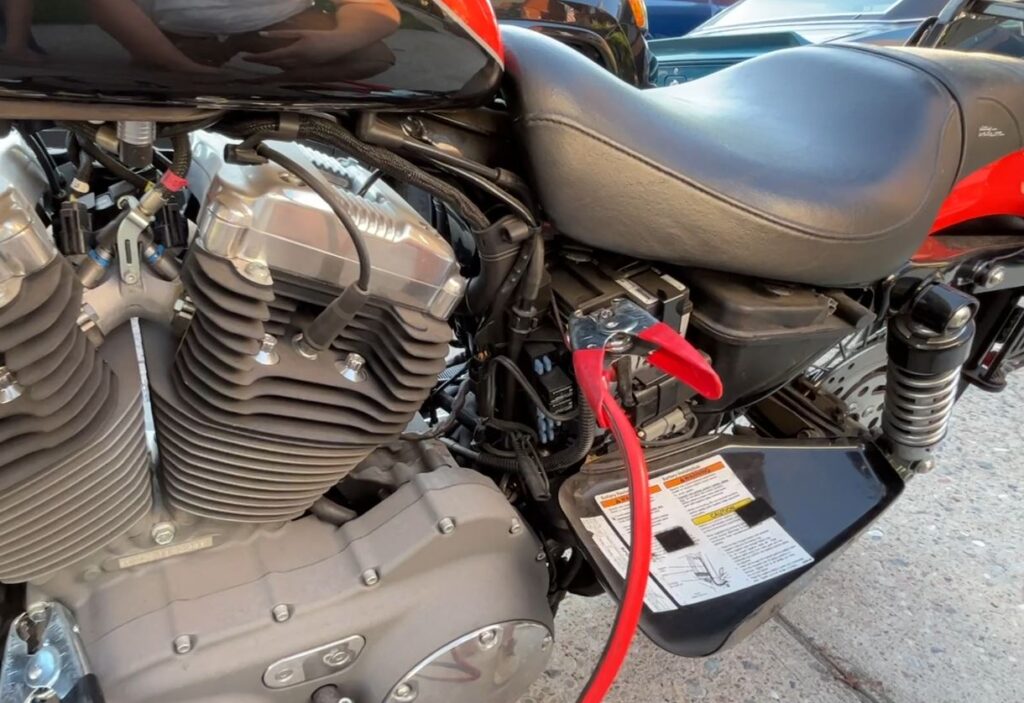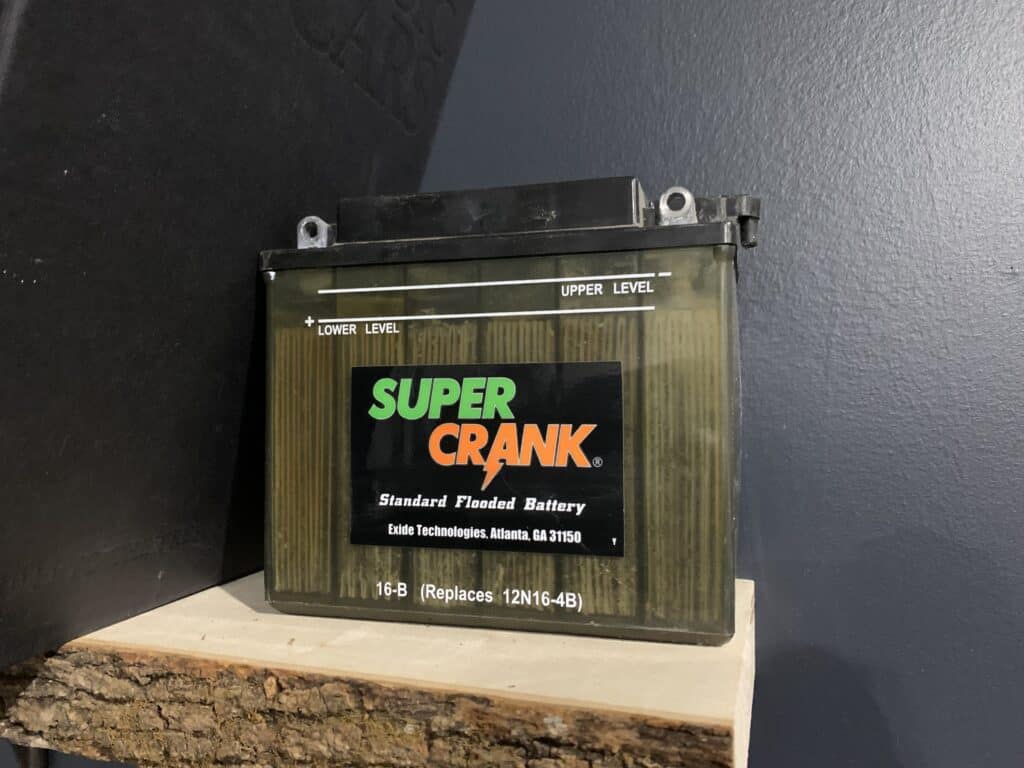
If you’re a motorcycle owner, you probably know that a motorcycle cannot function well if the battery isn’t at a full charge. Batteries are a vital part of how a motorcycle starts, so we need to pay special attention to them so they don’t cause grief down the road.
Winter time and cold temperatures can be especially tricky when it comes to taking care of a motorcycle battery. The extreme temperatures and lack of usage is hard on a battery, so winter maintenance is important.
So, how do you keep a motorcycle battery charged during the winter? To keep a motorcycle battery charged during the winter, you can connect a battery tender to it indefinitely throughout the season, occasionally use a trickle charger while supervising it, or completely disconnect it and keep it inside a controlled temperature environment and charge it in the spring.
It can be difficult owning a motorcycling while living in a place with harsh winters. I have lived most of my life in places with cold winters and found success using these methods to keep my motorcycle batteries charged.
How To Keep A Motorcycle Battery Charged During The Winter

Motorcycle batteries can be a bit finicky, especially when they’re left out in the cold. You may have noticed that the cold weather conditions greatly affect your motorcycle battery in a negative way.
- Battery Tender
The first step you can try to keep your motorcycle battery charged during the winter is hooking your battery up to a battery tender. This is my personal favorite and I practice this myself. Please note that a battery tender is different from a trickle charger (which we will cover later).
A battery tender is a device you can hook up to your motorcycle battery indefinitely throughout the winter. It has a sensor on it that will notify the system that the battery is starting to lose it’s charge and will automatically start charging it. Once it senses the battery is up to a full charge, it will automatically stop charging to prevent an overcharge. You essentially can let it do all the work without a worry.
Some people worry that the battery tender itself may freeze in the cold temperatures and fail to charge the battery. In most cases, you don’t need to worry because battery tenders are plugged in which prevents them from freezing.
- Trickle Charger
The second option you have is using a trickle charger. A trickle charger and a battery tender both charge motorcycle batteries, but a trickle charger is different because it gives a constant charge rather than turning on and off like a battery tender.
If you use a trickle charger, you’ll need to supervise the charge to ensure it does not overcharge the battery. It is completely possible to overcharge a battery and is evident if the motorcycle battery itself starts swelling and becomes hot to the touch.
You can use the trickle charger method occasionally and it will prolong the health of your motorcycle battery just fine.
- Disconnect And Store
The third option you have to keep your motorcycle battery charged during the winter is simply disconnecting it from the battery and bringing it inside where it remains in controlled temperatures until spring.
If you choose this option, make sure to put it in some sort of container to prevent anything from falling on it or in the case it tips over and leaks. Always keep it away from children, pets, and any source of heat.
While keeping your motorcycle battery inside during the winter, it will still slightly discharge, but not as much as it would remaining outside. You can either continue to occasionally charge it throughout the winter (but make sure you do so outside) or you can simply wait until spring to charge it. I’ve done this several times myself and have had a lot of success with it.
As a side note, it’s always important to check the motorcycle’s owner’s manual for specific battery maintenance recommendations.
Additional Motorcycle Battery Maintenance During The Winter
Aside from keeping the battery charged, there are several other things you can do to maintain and prolong the life of your motorcycle battery. These are things people often forget to check.
Be sure to occasionally check the battery cables and ensure they are not cracked or have become brittle. The exposed wires underneath can cause a short and drain the battery even quicker. If you plan on keeping your motorcycle battery connected to the motorcycle throughout the winter, make sure the connectors are always tight so dirt or dust doesn’t get in between and lessen the connection.
Any time you are handling the motorcycle battery, always use insulated tools (tools that have rubber casings around the handles) so you don’t end up shorting the terminals.
Make sure to not let your motorcycle battery lose more than 20% of it’s charge (or the charge doesn’t get below 80%). If it gets below this, it may lose it’s capacity to charge fully.
It’s also a good idea to always inspect the terminals and make sure there is no acid build up on them. It’s fairly common for this to happen, but this prevents a full connection from the cables and could potentially cause problems.
What Happens To A Motorcycle Battery During The Winter

Cold temperatures can inhibit a motorcycle battery’s ability to start a motorcycle. When a motorcycle has been exposed to cold temperatures for a certain amount of time, the oil inside the engine can lose some of it’s viscosity which makes the movement of the pistons a lot more difficult.
This, in turn, requires more power to get the motorcycle started in the first place. More power needed from an already inhibited, cold battery almost becomes impossible.
There is no exact temperature that can tell at what point a motorcycle battery can freeze. All of that depends on how charged or discharged the battery is. Much colder temperatures will be needed in order to freeze a fully charged motorcycle, while a discharged battery can freeze at just below freezing temperatures.
It’s important to know that a fully discharged motorcycle battery doesn’t mean it has zero voltage. A completely discharged battery means it has anything below 12 volts whereas a 100% charged battery should read 12.6 volts. So if you use a multimeter and notice your battery is below 12 volts, you know you’ll promptly need to charge it.
On top of the freezing temperatures hindering the functionality of a motorcycle battery, they also suffer from a phenomenon called parasitic drain.
The battery gets a normal, routine charge every time you ride your motorcycle because of the stator. The battery is only used to start the motorcycle and the stator continues to charge the battery while the motorcycle is running
Most riders use their motorcycle less in the winter; because the motorcycle battery isn’t getting the normal charge during rides, parasitic drain (poorly grounded wires that slowly discharge the battery) starts to take place. To learn more about how a motorcycle battery gets charged during rides, see our other article by clicking here.
Can A Cold Winter Destroy A Motorcycle Battery?
You may be wondering if a single cold winter could destroy or ruin a motorcycle battery if no maintenance or charging was performed on it. A lot of this depends on how cold the temperatures are, how old the battery is, and how discharged the battery is.
There does come a point where you will simply need a new battery. If your battery is a few years old and doesn’t have much of a charge to begin with during the winter, chances are the battery will need to be replaced. You can easily test the life of your battery through a multimeter.
It is also possible for a motorcycle battery to freeze if the temperatures are cold enough, you can learn more about that by reading my other article here.
Conclusion
Properly keeping your motorcycle battery protected and charged during the cold winter months could mean a much longer lifespan for that battery. You can easily do this by using a battery tender, trickle charger, or simply disconnecting it and storing it in a temperature controlled environment. I’ve used these methods several times myself and have found much success with it! Good luck with your winter storage my fellow riders!
Related Questions
How long can a motorcycle sit before the battery dies? The average motorcycle battery will die after 2 – 4 months without running. Newer batteries can last longer with an average of 3 – 5 months until dying whereas older batteries will have an average of 1 – 3 months until the battery dies while the motorcycle is sitting. Click here for more info.
Can you jump start a motorcycle from a car? It is possible to jump start a motorcycle using a car. However, there is a risk of ruining the motorcycle battery if it is done wrong. Leave both vehicles off while connecting the jumper cables. Once connected, leave the car off and attempt to start the motorcycle.
